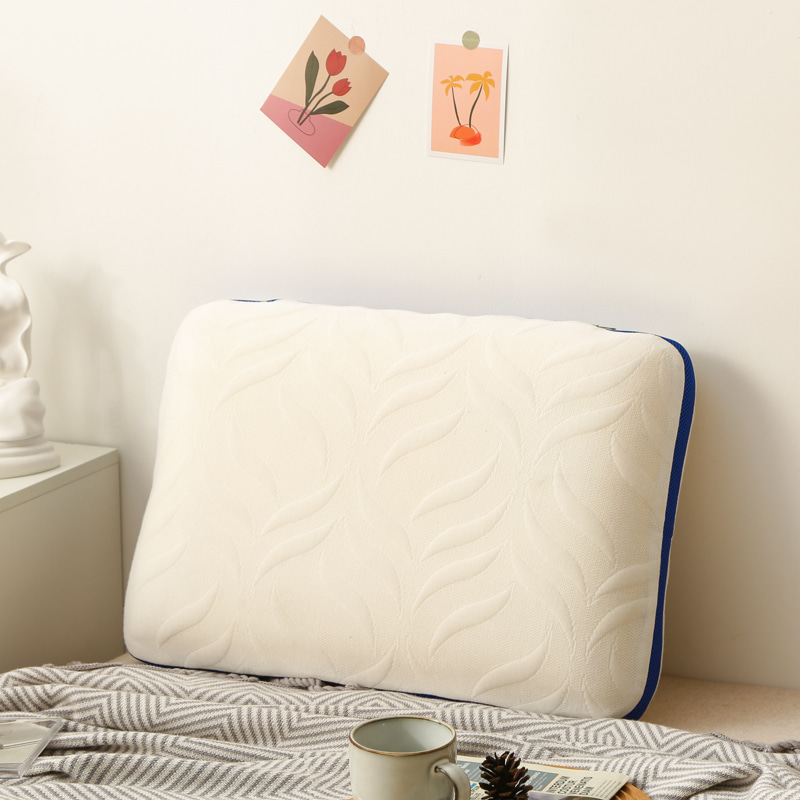The material properties of a contoured memory foam pillow directly affect its comfort and support. These properties determine how the pillow adapts to the human head, neck and shoulders during use, thereby providing optimal comfort and support.
Memory foam is a temperature-sensitive material that can adjust its shape according to changes in pressure and temperature. When the user places the head on the pillow, the memory foam senses the pressure of the head and gradually softens to perfectly fit the shape of the head and neck. This material responsiveness allows memory foam pillows to provide personalized support based on an individual's weight, sleeping position and body temperature.
Because memory foam can accurately adapt to the curves of the head and neck and reduce pressure points, users will not feel discomfort or numbness during sleep, providing a more comfortable sleeping experience than traditional pillows.
Memory foam provides support by dispersing pressure, especially in areas that require key support (such as the neck), avoiding the concentration of pressure in these areas by traditional pillows, thereby effectively preventing cervical problems.
The density and hardness of memory foam directly determine the support and comfort it provides. Memory foam with higher density is usually harder and can provide more support, suitable for people who need stronger support; while low-density memory foam is softer and focuses more on comfort, suitable for users who prefer soft pillows.
Because low-density memory foam is softer, it can provide a softer touch when used, helping users fall asleep quickly. High-density memory foam may feel slightly harder, but it can better support the neck and shoulders, especially for those who have cervical spine problems or need extra support.
High-density memory foam provides firmer support, especially when used for a long time, it can prevent the pillow from collapsing and maintain good support for the neck and head; low-density memory foam provides gentler support, suitable for mild support needs.

The temperature-sensing property of memory foam is one of its unique advantages. When the temperature rises, the memory foam becomes softer and can better fit the user's body contour; when the temperature drops, it becomes harder and provides more support. This feature allows memory foam to adjust comfort according to changes in the external environment.
In warm environments, memory foam softens and forms a more comfortable curve, making the user feel more comfortable; in colder environments, it provides firmer support to prevent the head and neck from sinking.
Warm memory foam can adjust its hardness as the temperature changes, so it can provide appropriate support in different sleeping environments. For example, in cold seasons, the pillow will become harder to provide stronger support for the head and neck, while in warm seasons, the pillow will become softer and provide a comfortable feeling.
Although memory foam has good support, it is relatively poor in breathability, which may cause overheating and sweat accumulation while sleeping. To solve this problem, many high-end memory foam pillows will add vents, gel layers or other breathable materials to the material to improve air circulation and temperature regulation.
If the breathability of memory foam pillows is poor, it may cause the surface of the pillow to overheat, which will affect comfort, especially in summer or warm climates. This can be improved by adding vents or cold gel layers, so that the pillow maintains a suitable temperature and improves comfort.
Increasing breathability does not affect the support of memory foam, but it helps to maintain the good performance of the pillow in different climates. Therefore, even after the breathability is improved, the memory foam can still maintain its efficient support ability.
Modern memory foam pillows usually use antimicrobial coatings or treated memory foam materials to reduce the growth of microorganisms such as bacteria, mold and dust mites. Antimicrobial properties not only improve the hygiene of the pillow, but also reduce the occurrence of allergic reactions.
Antimicrobial and hypoallergenic properties can provide additional comfort for users with sensitive skin, reduce skin discomfort or respiratory problems caused by allergies, and further improve sleep quality.
Antimicrobial coatings do not affect the support performance of memory foam, but help keep the pillow clean and extend its service life.
When choosing a contour memory foam pillow, consumers need to choose the most suitable product based on their personal sleeping position, body shape, temperature requirements and health needs.